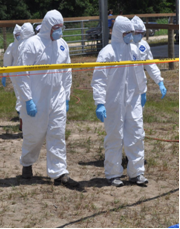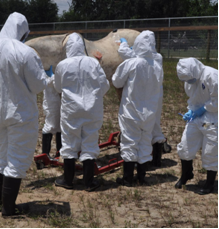
Vol. 6, No.6, June 2010 |
 Printer-Friendly PDF Version Printer-Friendly PDF Version |

Orlando/Altamonte Springs Hilton Selected as Site for 2011 SART Planning Meeting
The Hilton Orlando/Altamonte Springs has been selected as the site for the February 28-March 2, 2011 SART Planning Meeting; it is a member of the Dept. of Environmental Protection’s Green Lodging Program. “The Hilton offered a combination of best rates and superb facilities, all recently remodeled,” says Michael Turner, SART planner who negotiated with various hotels and conference facilities. “Plus, they are central, sort of equidistant for people from south Florida and the northwest.”
ESF-17 ECO Joe Kight says he anticipates about 200 conference attendees and is putting together a conference program that is both highly informative and participatory. “We want to maximize the learning and networking potential,” Kight says. “We want people to depart the conference with fresh ideas and hope that the new commissioner of the Department of Agriculture and Consumer Services will be able to give us a keynote speech at the planned Tuesday luncheon – in the same manner that Commissioner Bronson spoke to us in 2007. So with a combination of individual presentations, panel discussions and problem-solving working groups this could be a very informative event. And by the way, because of a couple of very generous donations there will not be a registration fee!”
Please “stay tuned” to the Sentinel for additional information as it becomes available. Meanwhile questions may be directed to either Michael Turner (turnerm@doacs.state.fl.us) or Joe Kight (kightj@doacs.state.fl.us). Information about the Hilton Orlando/Altamonte Springs is at http://www1.hilton.com/en_US/hi/hotel/ALTAHHF-Hilton-Orlando-Altamonte-Springs-Florida/index.do
Gibbs' Instruction Simulates Outbreak of Glanders in Equines
Photos courtesy John Haven
Current FDACS/WIFSS Course Schedule
Several courses are still available in the FDACS/Office of Agricultural Emergency Preparedness partnership with WIFSS, the Western Institute for Food Safety & Security, that is bringing DHS Certified Agroterrorism Courses to Florida. Courses are free and lunch is provided.

AWR-153 Principles of Detection and Diagnosis: Strategies and Technologies
- Wednesday, June 23 – Pensacola: 8:30 a.m. to 4:00 p.m. Escambia County Public Safety, 6575 North “W” St., Pensacola, FL 32505
AWR-154 Principles of National Incident Management System (NIMS), Team Building, and Risk Communication
- Thursday, June 24 – Tallahassee: 8:00 a.m. to 4:00 p.m. Betty Easley Conference Center, Room 152, 4075 Esplanade Way, Tallahassee, FL 32399
- Tuesday, July 20 – Orlando: 8:00 a.m. to 4:00 p.m. Orange County Sheriff’s Office Central Operations Center Mel Martinez Auditorium, 2500 W. Colonial, Orlando, FL 32804
- Wednesday, July 21 – Gainesville: 8:00 a.m. to 4:00 p.m. USDA FSA, 4401 NW 25th Pl., Gainesville, FL 32606
- Thursday, September 16 – Jacksonville: 8:00 a.m. to 4:00 p.m. Jacksonville Regional Operations Center, 921 N Davis St., Bldg. E, Jacksonville, FL 33209
Additional sponsoring partners include UF’s IFAS-Extension, the Florida Department of Health and the Regional Domestic Security Task Forces.
Registration: http://wifss.ucdavis.edu/agroterrorism/classes/classesbydate.php
Information: http://wifss.ucdavis.edu/agroterrorism/classes/course_desc.php
For questions contact John Terry (850) 410-6756/251-4184 terryj1@doacs.state.fl.us
[top]
John Haven Receives Distinguished Service Award
 "Winning the Distinguished Service award is an honor not only for John Haven but all members of SART," says Joe Kight, ESF-17 ECO. "SART is made up of many great partners and many of them could have won this award."
"Winning the Distinguished Service award is an honor not only for John Haven but all members of SART," says Joe Kight, ESF-17 ECO. "SART is made up of many great partners and many of them could have won this award."
On May 27th, Florida SART’s John Haven, Director of UF’s College of Veterinary Medicine received a Distinguished Service Award at the 2010 Governor’s Hurricane Conference in Ft. Lauderdale. Governor Charlie Crist himself presented the award which read: “For his significant contribution in the state’s disaster preparation and response effort involving the rescue and care of large and small animals.”
“While I am certainly excited to receive the award,” said Haven, “it wouldn't have been possible without the effort
and support of my team members at UF, and our SART partner agencies. It is great for SART for our efforts in animal and agricultural issues to be recognized at such a high level."
With Florida ESF-17 Joe Kight and FDACS’ David Perry, Haven presented a Wednesday morning conference program titled, “How Do You Include Animal Preparedness in Your Evacuation Plan?” Kight noted that this is the third time that a member of the SART team has been recognized.
Rope Training Builds Skills for Large Animal Rescue
The week of May 3-7 members of the UF VETS Large Animal Technical Rescue Team (John Haven, David John, Josh Fleming and Dr. Roger Clemmons), Dr William Shelton from Florida Vet Corps, Brooke Vrany from Day’s End Farms Horse Rescue and James Brown from Gainesville Fire Rescue, participated in the Structural Rope Rescue – Technician Level course, provided by Wright Rescue Inc. Lt. Pat West and Joey Gonzalez, both of Gainesville Fire Rescue, taught the course for Wright Rescue.

The team enhanced its knowledge in rigging for both high and low angle rescue of large animals. It also addressed advanced rescue concepts including rescuing injured team members and “high line” or controlled “zip line” techniques. The team had the benefit of practicing at the UF Veterinary College, the O’Connell Center and UF’s Ben Hill Griffin Stadium.
 | 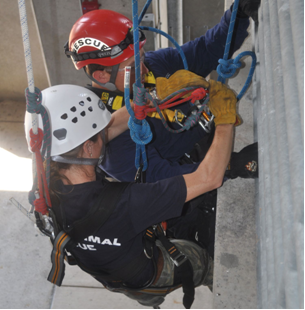 |
| John Haven guides patient Lt. Pat West down a wall inside the UF football stadium. | Brooke Vrany rescues firefighter Joey Gonzalez inside a stairwell of the stadium. |
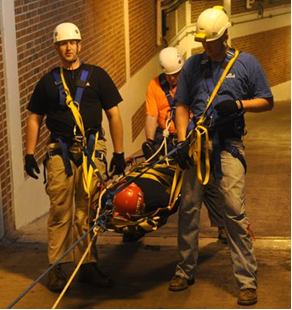 | 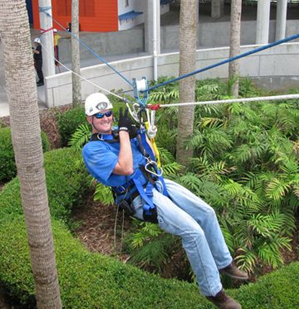 |
| David John (l), Dr. Roger Clemmons (rear), Josh Fleming (r) and Lt. Pat West (patient on stretcher) practice a low angle rescue. | Josh Fleming is lowered across a "high line" outside UF’s famous “Swamp” football stadium. |
Does a Florida team have a need for such training?
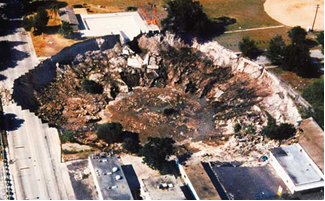 Florida's limestone sub-surface or Karst topography is characterized by subterranean limestone caverns, carved by groundwater. Chemical dissolution can cause a sinkhole to open practically anywhere.
Florida's limestone sub-surface or Karst topography is characterized by subterranean limestone caverns, carved by groundwater. Chemical dissolution can cause a sinkhole to open practically anywhere.“Not only are there sink holes in Florida,” says John Haven, “but there are deep canals such as in Pinellas Park, and steep grades in some areas where people trail ride. Before we can conduct a rescue, we need to make sure we can keep our team safe throughout the effort. Some of the high end training also gives our team practice and techniques to approach basic problems from very different perspectives. When at all possible we want to rescue the animal in the simplest manner.
“Some of the advanced training was also aimed at being able to rescue our own team members – on a deployment we may not have fire rescue readily available. This was Technician Level training for our team, and without a strong Operations Level, it would be too much for just anyone to jump into. It was a week long and fairly expensive. I don’t anticipate another one like this for the remainder of the year.
“The provider, Wright Rescue, is based in Panama City and has classes for those who
really want to become rope rescue experts, to sign up for an Operations Level Course at their campus. Wright Rescue has a great interest in large animal technical rescue and has worked with the college for several years now.
“I strongly recommend DART team or other responders learn some of the basics since they need to be prepared for large animal or small animal rescue and sheltering. Not every rescue is going to require high angle techniques and equipment – in fact few really do.”
Has this training ever been put to practical use here?
“The VETS team is equipped and trains to operate as a high capability team. It assisted Marion County Fire Rescue in a high angle rescue last year. The VETS team provides a limited number of trainings in North Central Florida – it allows the team to train with personnel it may be involved with during a response.”
Do you work with other recommended trainers?
“While I don’t typically recommend one private business over another, TLAER provides an excellent and affordable multi-day awareness level course to help get people the basics. It is primarily lecture, which allows the class sizes to be larger than in an Operations or Technician Level class, which have higher hands on requirements and skills mastery. TLAER’s Dr. Gimenez is involved with me in the NASAEEP Training Committee, so I’m familiar with the course components and where it is going with the national training standards.
“Anyone from SART can email me [havenj@ufl.edu] with training questions for large animal rescue, or for small animal hospital/sheltering exercises.”
[top]
More Photos From SART Training Weekend in Bushnell
Photos courtesy Laura Bevan
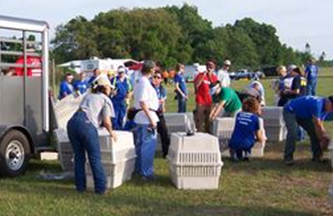 | 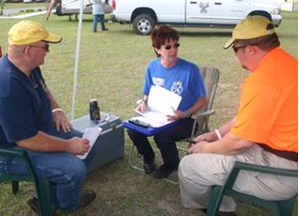 |
| Unpacking crates on Day 1, Saturday April 24. | Field problem solving (l-r): David Perry, Pam Burns and John Haven. |
 | 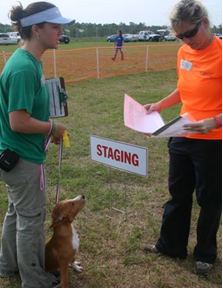 |
| A bath and a brush on a hot day. (“Maybe a tummy rub is next….”) | Ready to begin the decon process: even the dog appears alert! |
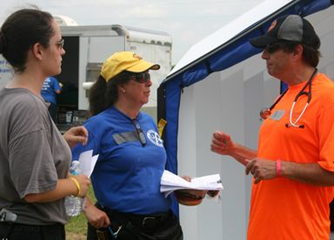 | 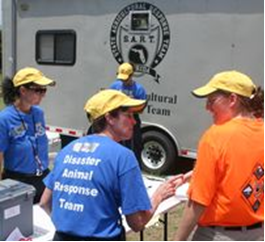 |
| A field exercise requires that many organizations and individuals, often unknown to one another, work in unison. | A successful mission requires organization, structure and flexibility. |
[top]
Keeping up With a Changing World

USDA-APHIS Veterinary Services believes the animal landscape in the U.S. is changing. A few of the factors at work are changes in technology and production practices, globalization and increasing demand for animals and animal products. Thus Veterinary Services has been attempting to work ahead to see what its role in animal care (including, derivatively, the human animal) will be five years from now in Vision 2015.
The current VS 2015 coordinator, Dr. Roxanne Mullaney was formerly Area Veterinarian in Charge for New York. Four working groups report to her: One Health, Surveillance for Action, Movement and Marketability, and Agriculture Emergency Management Preparedness and Response Planning. Groups are comprised of VS staff, but state partners are joining each group this spring.
For more information on VS2015, contact Dr. Mullaney at vs2015@aphis.usda.gov or visit http://www.aphis.usda.gov/about_aphis/programs_offices/veterinary_services.
[top]The Strangest Invasive Species
 A “natural” bee hive in the merlot of Australia’s Blue Poles Vineyard. Apis mellifera is cultivated around the world because it is a fine pollinator and relatively easy to work with.
A “natural” bee hive in the merlot of Australia’s Blue Poles Vineyard. Apis mellifera is cultivated around the world because it is a fine pollinator and relatively easy to work with.We tend to think of out-of-place species as “invasives.” Examples are the fast-growing melaleuca tree, a native of Australia now burying many parts of south Florida, or the Nile monitor lizard, described by the U.S. Geological Service as “an invasive species that now lives in Florida…and sometimes hunt(s) in packs.”
What about species that we have purposefully introduced that work out just fine, species that find a niche and flourish? In the Midwest it might be the Ring-necked pheasant which was first brought to the U.S. in 1857. Otherwise, the honeybee is our most successful introduction although with so many agenda items, from puppy mills to oil spills, its plight is temporarily overlooked. In 2005, Varoa mites infected hives and decimated colonies. Then in 2007 the term “colony collapse disorder” entered our vocabulary. It meant that virtually world wide, the honeybee – apis mellifera and related subspecies – were disappearing, evacuating their hives and apparently dying.
It was reminiscent of the dark scenes from Douglas Adams Hitchhiker’s Guide to the Galaxy (1984) wherein dolphins begin to disappear saying, “So long and thanks for all the fish.”
Because honey bees are superb pollinators the queens – without which a hive will not function – are shipped worldwide and thus a condition from India or Spain soon arrives in Florida. It is a vast world industry because honey bees are wonderful pollinators and are relatively docile [unlike, for instance, the Africanized bee which is also a pollinator though extraordinarily difficult to handle]. It is indeed a “small world after all.”
Unfortunately, as research continues into the complex of problems affecting the bees – from mites to viruses to malnutrition – the disorder has spread. Bees pollinate apples, pumpkins, watermelons, blueberries, cherries, cucumbers, cantaloupe, almonds…the list goes on. Imagine a world without them or wherein, like the often reported tale from China where pears are pollinated by hand, many of our foods become terribly expensive. So please stay tuned for updates if and when there is a breakthrough.
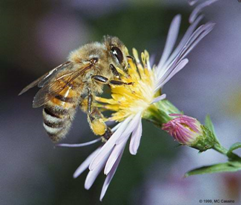
“There has been a tremendous increase in the interest in honeybees and beekeeping in Florida,” writes Jerry Hayes , chief of the apiary section of FDACS. “Much of this interest and awareness is the result of reports about honeybee health challenges and colony collapse disorder.
“An interest in honey bees and ‘saving’ them if you will has manifested itself in many people choosing to become hobby backyard beekeepers. Just a few years ago there were approximately 750 Registered Beekeepers in Florida. As of June 7th there are 1,663! An amazing growth that I have certainly never seen before in my many years associated with the industry. This growth is incredible and certainly speaks for the importance to the environment and agriculture that people perceive is the result of having honey bees to pollinate and provide food for us wild animals, birds and seeds for plants to reproduce.
“The professional, commercial industry of beekeepers having thousands of managed honey bee colonies is still struggling with consistent 30% losses on a national average each spring. This loss may be the new business model for these small business men and women. They have to adapt or go out of business.
“If you are in any other kind of small business and you experience an average of 30% loss or if you are in the 40%-50%- 60% loss category you won’t be in business very long. USDA projects that the U.S. will import approximately 40% of our veggies by 2012 and that the U.S. will be a Net Food Importer in a generation.
“So I guess if we don’t care where food comes from these losses of honey bees is OK. We already have to import energy supplies. Now we are turning our food production over to some other country. Not a great idea in my mind. A healthy honeybee industry is necessary to sustainable agricultural production in the U.S.”
IFAS Says 2010 Bee College a Success
With 250 people in attendance, the 2010 IFAS Bee College – the third annual educational event – was a success. Held at UF’s Whitney Marine Laboratory in Marineland (south of St. Augustine on A1A), the two-day program on March 12-13 covered almost all phases of beekeeping and an introduction to the honey industry in 60 lectures, classes and workshops. It even included a Junior Bee College for young people from 6-18, a statewide honey competition, art exhibits and training to become a certified “Welsh Honey Judge.”
 Jerry Hayes, chief of FDACS apiary section (r), visits with Miami firefighter/paramedic and trained animal responder Lloyd Brown at the 2007 SART conference.
Jerry Hayes, chief of FDACS apiary section (r), visits with Miami firefighter/paramedic and trained animal responder Lloyd Brown at the 2007 SART conference.According to UF’s Catherine Zettel, “Bee college is designed for beekeepers, those interested in becoming beekeepers and people who just love bees. Classes range from how to work a hive to instrumental insemination and queen rearing. Participants can even learn how to make mead!”
A special Friday afternoon session discussed the Africanized honeybee [the so-called “killer bee”] for first responders. A Saturday morning certification class taught by Dr. Bill Kern covered the topic from a pest control standpoint, the safe and effective removal of African bees.
Welsh Honey Judging, by the way, is “the most stringent training in the world for would-be honey judges,” says UF-IFAS Dr. Jamie Ellis…and there is a test! There are four requirements: attend the Friday training, have documented experience as a “steward” (a certified judge’s assistant), then documented experience as a senior honey show judge and passing the oral exam.
The 2011 Bee College is tentatively set for March 11-12 at Whitney Marine Laboratory. For additional information about UF’s Bee College call Glinda Burnett at (352) 273-3904 and watch on-line at: http://entnemdept.ufl.edu/honeybee/extension/bee_college.shtml.
The day before the Bee College, we hosted our Master Beekeeper training and exams, says Zettel. Our Master beekeeper program was started three years ago in response to the need for people around the state who could educate the public about bees. Our program currently has 140 participants, and has reached over 2 million people through outreach activities. Training and exams are held twice a year, and the Master Beekeeper Program continues to grow.
[top]
About the SART Sentinel |
Editor: Rick Sapp, PhD, Technical Writer, Florida Department of Agriculture & Consumer Services, Division of Animal Industry [rsa5@cox.net] Associate Editor: Joe Kight, State ESF-17 Coordinator, Florida Department of Agriculture & Consumer Services, Division of Animal Industry [kightj@doacs.state.fl.us] The SART SENTINEL is an E-mail newsletter prepared monthly by Rick Sapp and the members of the Florida State Agricultural Response Team. Past issues of the Sentinel are archived on the Florida SART Web Site, www.flsart.org. If you have a story or photo that you would like to have considered for publication in The SART SENTINEL, please contact the Editors. [top] |


